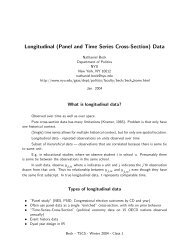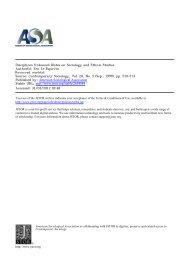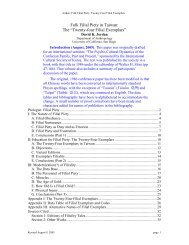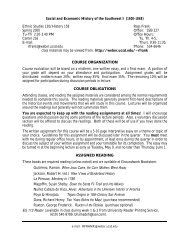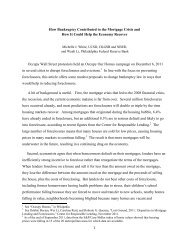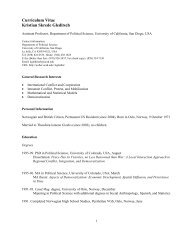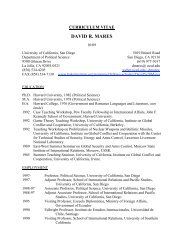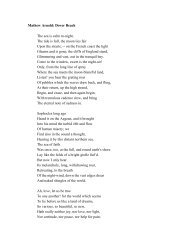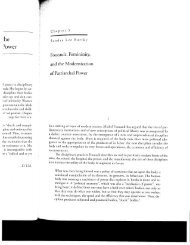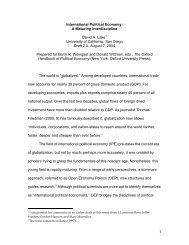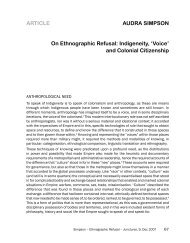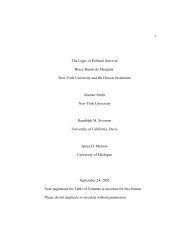Climate change and water resources in the Murray Darling Basin ...
Climate change and water resources in the Murray Darling Basin ...
Climate change and water resources in the Murray Darling Basin ...
You also want an ePaper? Increase the reach of your titles
YUMPU automatically turns print PDFs into web optimized ePapers that Google loves.
ABARE CONFERENCE PAPER 02.11<br />
Dem<strong>and</strong> for <strong>water</strong> is high <strong>in</strong> <strong>the</strong> <strong>Murray</strong> Darl<strong>in</strong>g Bas<strong>in</strong> <strong>and</strong> an audit of <strong>water</strong> use <strong>in</strong> 1995<br />
showed that if <strong>the</strong> volume of <strong>water</strong> diversions cont<strong>in</strong>ued to <strong>in</strong>crease, river health problems<br />
would be exacerbated, <strong>the</strong> security of <strong>water</strong> supply for exist<strong>in</strong>g users would be dim<strong>in</strong>ished,<br />
<strong>and</strong> <strong>the</strong> reliability of <strong>water</strong> supply dur<strong>in</strong>g long droughts would be reduced. Consequently,<br />
a cap was imposed on <strong>the</strong> volume of <strong>water</strong> that could be diverted from <strong>the</strong> rivers for<br />
consumptive uses. The cap limits fur<strong>the</strong>r <strong>in</strong>creases <strong>in</strong> <strong>water</strong> diversion but does not constra<strong>in</strong><br />
new developments provided <strong>the</strong>ir <strong>water</strong> requirements are met by us<strong>in</strong>g current allocations<br />
more efficiently or by purchas<strong>in</strong>g <strong>water</strong> from exist<strong>in</strong>g developments.<br />
Global climate <strong>change</strong> – <strong>the</strong> SRES scenarios<br />
The IPCC developed a series of greenhouse gas emission scenarios to reflect <strong>the</strong> current<br />
underst<strong>and</strong><strong>in</strong>g of <strong>the</strong> likely trends <strong>in</strong> future emissions <strong>and</strong> <strong>the</strong> uncerta<strong>in</strong>ties that surround<br />
<strong>the</strong>se trends. The differences <strong>in</strong> <strong>the</strong> scenarios are <strong>in</strong>tended to represent <strong>the</strong> range of uncerta<strong>in</strong>ty<br />
associated with <strong>the</strong> paths that <strong>the</strong> key drivers of emissions — population growth,<br />
economic growth <strong>and</strong> technological <strong>change</strong> — may take over <strong>the</strong> next century. There are<br />
four basic SRES storyl<strong>in</strong>es. At one extreme, high levels of both economic <strong>and</strong> population<br />
growth coupled with slow <strong>and</strong> limited adoption of clean, resource efficient technologies<br />
lead to <strong>the</strong> largest <strong>in</strong>crease <strong>in</strong> emissions. At <strong>the</strong> o<strong>the</strong>r extreme is a scenario with low population<br />
growth <strong>and</strong> a fairly rapid shift <strong>in</strong>to resource efficient technologies <strong>and</strong> a reduction <strong>in</strong><br />
<strong>the</strong> material <strong>in</strong>tensity with <strong>the</strong> use of pollution enhanc<strong>in</strong>g processes <strong>and</strong> materials.<br />
At <strong>the</strong> same time <strong>the</strong>re is considerable uncerta<strong>in</strong>ty about <strong>the</strong> extent of global warm<strong>in</strong>g<br />
associated with a given trend <strong>in</strong> emissions, <strong>and</strong> <strong>the</strong> sensitivity of <strong>the</strong> climate to greenhouse<br />
trends. For each of <strong>the</strong> four SRES storyl<strong>in</strong>es, a set of global climate <strong>change</strong> models was<br />
used to generate potential levels of global warm<strong>in</strong>g to <strong>the</strong> year 2100 for each scenario.<br />
The different models were used to establish high, medium <strong>and</strong> low levels of climate sensitivity<br />
for each scenario. The advantage of us<strong>in</strong>g several models was that <strong>the</strong> scenarios<br />
toge<strong>the</strong>r encompass <strong>the</strong> current range of uncerta<strong>in</strong>ties about future greenhouse gas emissions,<br />
<strong>in</strong> addition to <strong>the</strong> current knowledge of, <strong>and</strong> uncerta<strong>in</strong>ties associated with, <strong>the</strong> driv<strong>in</strong>g<br />
forces underly<strong>in</strong>g <strong>the</strong> scenarios.<br />
Over <strong>the</strong> full set of SRES scenarios <strong>and</strong> model projections, <strong>the</strong> level of global warm<strong>in</strong>g <strong>in</strong><br />
2100 ranges from 1.4 to 5.8°C relative to 1990. Figure 2 shows <strong>the</strong> envelope for projections<br />
<strong>in</strong> temperature rise under <strong>the</strong> SRES scenarios, with scenario A1F high generat<strong>in</strong>g<br />
<strong>the</strong> largest <strong>in</strong>creases <strong>in</strong> temperature, <strong>and</strong> B1 low <strong>the</strong> smallest <strong>in</strong>creases. The projections<br />
<strong>in</strong>dicate that warm<strong>in</strong>g will vary by region <strong>and</strong>, while overall precipitation is expected to<br />
<strong>in</strong>crease over <strong>the</strong> com<strong>in</strong>g century, <strong>the</strong>re are projected regional <strong>in</strong>creases <strong>and</strong> decreases <strong>in</strong><br />
average ra<strong>in</strong>fall over l<strong>and</strong> masses. Larger year to year variations <strong>in</strong> precipitation are very<br />
likely. The <strong>in</strong>tensity <strong>and</strong> frequency of extreme wea<strong>the</strong>r events is also expected to <strong>in</strong>crease<br />
(IPCC 2001).<br />
5




